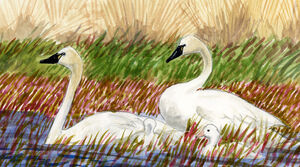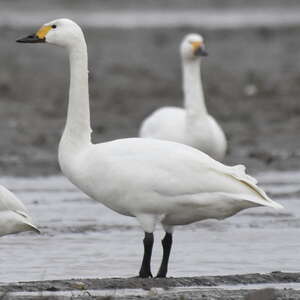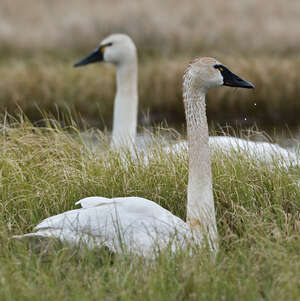Tundra Swan
Cygnus columbianus - Cygne de Bewick Cygne siffleur
Identification
The Tundra Swan is currently considered a subspecies of the Whistling Swan, a Holarctic species whose scientific name is Cygnus columbianus bewickii. It is found in Eurasia. The North American subspecies C. c. columbianus is the nominate subspecies, also known to English speakers as the Tundra Swan. The Whistling Swan is a much smaller species than either Trumpeter or Mute Swans. Here, I will primarily discuss the Tundra Swan.
There is no sexual dimorphism; the male is simply slightly larger. The adult plumage is entirely white. During breeding season, the head and neck are often reddish brown due to feeding on submerged vegetation. The bill, with its concave culmen, is black and yellow. The yellow originates from around the eyes and reaches the nostrils down the upper mandible in an arc. The eye is dark and the legs are black. The birds in the eastern part of the continent have a break in the yellow around the forehead. American birds often have only a single arc of yellow at the lore, with the yellow reaching the black bill slightly more in some individuals.
The juvenile and first winter birds can be readily distinguished by their overall brownish, grayish and rufous plumage, with the head and neck usually being the darkest areas. The bill is pink and black, without yellow at the base. The eye is circled in pale tones and the legs are grayish pink. The bill and legs will darken in the second year, though the yellow of the bill will take longer to develop. Immature birds can still be identified as such throughout their second winter. They will not typically breed until they are three or four years old.
Subspecific information 2 subspecies
- Cygnus columbianus columbianus (Alaska, n Canada)
- Cygnus columbianus bewickii (n Eurasia)
Foreign names
- Cygne de Bewick,
- Cisne chico,
- cisne-pequeno,
- Zwergschwan,
- kis hattyú,
- Kleine Zwaan,
- Cigno minore,
- mindre sångsvan,
- Dvergsvane,
- labuť malá,
- labuť malá,
- Tundrasvane,
- pikkujoutsen,
- cigne petit,
- Dvergsvanur,
- łabędź czarnodzioby,
- mazais gulbis,
- mali labod,
- Американский лебедь,
- コハクチョウ,
- 小天鹅,
- 小天鵝,
Voice song and call
Habitat
The Tundra Swan nests on the edge of water bodies and in wetlands of Russian Arctic. Delta areas are especially favourable for it, while inland waters are less so.
During migration and winter, the choice is wider - it makes halts in inland wetlands, large shallow freshwater bodies, contiguous marshes and adjacent crops. Wintering sites are roughly the same but additional marshes of the tidal zone, estuaries, rice paddies, agricultural areas with crop residue and cereal fields are included, to the displeasure of farmers. It can also be observed on completely bare mudflats, for instance, on water bodies being drained, since, in addition to rhizomes of Potamogeton, it can also consume invertebrates such as molluscs in this season.
Behaviour character trait
The Tundra Swan is a very social bird during the inter-breeding season. Hundreds of birds can flock to favourable wintering grounds.
It's easy to differentiate families since couples stay together and young remain with their parents throughout their first winter, or even longer.In mainland France, this swan mainly frequents drained or shallow water bodies and it is amusing to watch them forage on the exposed mudflats. It reminds us of the potential food sources - both plants and animals - existing in the mud.
Its call is rather melodious and it deserves to be called the 'Singer Swan', at least to the same extent as its cousin C. cygnus.
Flight
Dietfeeding habits
The Tundra Swan is primarily vegetarian. It consumes, both taxonomically and categorically, all parts of the higher plants, including roots, tubers, rhizomes, stems and leaves, as well as seeds or fruits, selecting the nutritionally most beneficial species and items to ensure adequate caloric intake.
On breeding sites, it feeds in shallow water, dipping its head and neck under the water to collect its vegetable food. Potamots, submerged plants, are highly attractive to it, but it also favours carex, glycérie and other poacées, buttercups, young shoots of phragmites, and the like. It also rarely takes some invertebrates, chiefly mollusks.
During winter, it feeds in coastal wetlands, some continental areas, and neighbouring farmland, hydrophilic meadows and crops, for instance in Dutch polders. Cultivated fields provide it with seeds and tubers, and in Eastern parts of the continent, rice fields do the same. Coastal salt marshes offer it some animal supplement, mollusks, polychaete annelids, and so on. The same happens in continental marshes, but the organs of resistance of the plants, roots, rhizomes, turions and seeds, still remain of major importance. It may also occasionally feed on young cereal crops, much to the farmer's dismay, who used to shoot it in the past.
Reproduction nesting
The Tundra Swan reaches sexual maturity at the age of 3 or 4 years. Partners arrive together at the breeding site, at a date that depends on the latitude and snow level, in general from late march to late may.
Nesting occurs a few days before laying but adults continue to load the nest during laying and incubation. The nest is built on the edge of water, on an elevation, an islet or an island, with surrounding vegetation. It is 50cm in diameter. Often, the previous year's nest is reused. The female lays 3 to 6 cream-white eggs which gradually darken in contact with the nest. Incubation takes 30 days, mostly provided by the female. The chick is covered with a light gray down and has a pink beak. The brood leaves the nest fairly quickly after the end of hatches, but the female can still care for her young if necessary. They can feed themselves but adults provide them with food. The family will stay together throughout the inter-season, the young leaving the adults only when they go to the breeding sites. They may find them again in the following autumn.Geographic range
The Tundra Swan nests in Russian Arctic, from the Kalin Peninsula in European Russia to the Bering Strait. It is a long-distance migrant. It winters in Western Europe, mostly in the British Isles and around the North Sea, a little on the continent, and then west of the Black Sea, south of the Caspian Sea, and especially in Japan, Korea, and eastern China.
Threats - protection
IUCN conservation status
concern
in the Wild
threatened
evaluated
BirdLife International does not consider Tundra Swan as endangered due to its wide distribution, but the current trend of the population is unknown. However, it can be assured that it is not in severe decline.
In the past it was less protected than it is nowadays and could be shot. This is no longer the case.
Nesting sites of the Siberian tundra are threatened by gas and oil extraction works.
Sources of information
- IOC World Bird List (v15.1), Gill, F and D Donsker (Eds). 2025-12-07.
- Canards, cygnes et oies d'Europe, d'Asie et d'Amérique du Nord, Reeber Sébastien
- Guide des canards, des oies et des cygnes, Steve Madge
- Les palmipèdes d'Europe, Géroudet P., MAJ M. Cuisin
- Wildfowl: An identification guide to the ducks geese and swans of the world, Madge, S and Burn, H
- Avibase, Lepage Denis
- Birds of the World, The Cornell Lab of Ornithology
- xeno-canto, Sharing bird sounds from around the world,
Other sources of interest
 Specification sheet created on
27/07/2023 by Jean François
Specification sheet created on
27/07/2023 by Jean FrançoisTranslation by AI Oiseaux.net
© 1996-2025 Oiseaux.net
- Accipitriformes
- Aegotheliformes
- Anseriformes
- Apodiformes
- Apterygiformes
- Bucerotiformes
- Caprimulgiformes
- Cariamiformes
- Casuariiformes
- Charadriiformes
- Ciconiiformes
- Coliiformes
- Columbiformes
- Coraciiformes
- Cuculiformes
- Eurypygiformes
- Falconiformes
- Galliformes
- Gaviiformes
- Gruiformes
- Leptosomiformes
- Mesitornithiformes
- Musophagiformes
- Nyctibiiformes
- Opisthocomiformes
- Otidiformes
- Passeriformes
- Pelecaniformes
- Phaethontiformes
- Phoenicopteriformes
- Piciformes
- Podargiformes
- Podicipediformes
- Procellariiformes
- Psittaciformes
- Pterocliformes
- Rheiformes
- Sphenisciformes
- Steatornithiformes
- Strigiformes
- Struthioniformes
- Suliformes
- Tinamiformes
- Trogoniformes
































